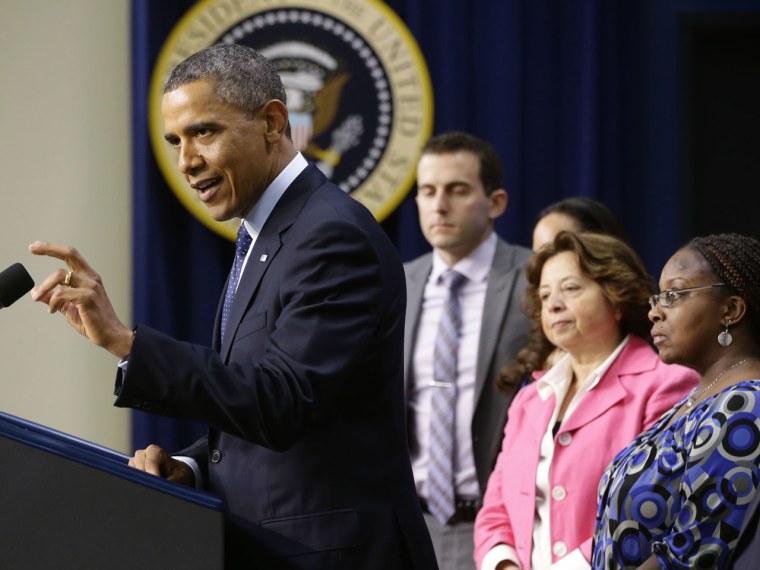What was perhaps most revealing about the final deal reached by President Obama and congressional Republicans to avert the so-called "fiscal cliff"--or "fiscal curb," as we've been calling it at Up w/ Chris Hayes--is what it told us about who Washington actually serves, and what lawmakers think "middle class" actually means.
The deal, of course, raised marginal income tax rates for individuals making more than $400,000 a year. Nominally, as The New York Times reported today, this makes the federal tax code--at least as it appears in statute--more progressive than it has been in decades. The actual effect of the deal, however, was to raise taxes on 77% of American households, while giving away billions in tax breaks to politicians' corporate patrons.
That's because lawmakers on both sides of the aisle agreed from the outset not to fight for an extension of the payroll tax holiday signed into law by President Obama two years ago. That provision cut earners' payroll tax liability by 2%. And while almost all households benefited in some way from the payroll tax cut, it was especially helpful to lower and middle income Americans, both because the payroll tax is capped at the first $110,000 of income and because higher earners tend to make more from investments, which are taxed at lower rates.
This statistic, for example, tells you everything about who lawmakers were really looking out for in the negotiations: Among Americans who make between $20,000 and $30,000 a year, 66.9% pay more in payroll tax than income tax, according to the Tax Policy Center. To those people, the payroll tax is what matters more. It's what takes the bigger bite out of their paychecks.
Among Americans who make between $200,000 and $500,000 a year, 97.6% pay more in income tax than payroll tax. To them, the Bush tax cuts were a boon. And since income taxes went up only on income over $400,000, it's easy to see who won in that battle. Citizens for Tax Justice estimates that people who make in the range of $279,000 will get a tax cut of about 3%, compared to just 1.9% for people making an average of $14,000 a year.
This arrangement proves a few things. For one, it turns out Republicans aren't averse to raising certain kinds of taxes, as long they don't burden wealthier Americans. "The Republicans have always been against tax cuts for lower and middle income people," Rep. Jerry Nadler, Democrat of New York, said Saturday on Up w/ Chris Hayes.
The arrangement also proves that neither side really cares about deficit reduction. The payroll tax increase, for example, will save about $95 billion in 2013 alone. But Congress turned around and gave most of that savings away in tax breaks for businesses like NASCAR, Hollywood studios and Wall Street. The Joint Committee on Taxation estimates that those so-called "tax extenders," tucked into the bill with little notice, will cost $68 billion in 2013.
Lastly, the arrangement lays bare how power is wielded in Washington: Not just in decision-making, but in agenda-setting. The current artificially induced crisis is all about deficits and spending cuts--issues that, studies have shown, are much more important to wealthier Americans. The political class has apparently convinced itself that unemployment is no longer a problem, despite the fact that only 58% of Americans have jobs, essentially the lowest number since 1983 and virtually unchanged since the end of the recession.
The expiration of the payroll tax cut may only make that worse. According to the Congressional Budget Office, the payroll tax cut did much more to stimulate the economy than income tax cuts, because most households pay more in payroll tax than income tax.
As Sen. Tom Harkin, Democrat of Iowa, put it in a floor speech on Monday, the deal is only a victory for the middle class if you skew what "middle class" means.
"If you make $250,000 a year, you’re not middle class. You’re in the top 2% of income earners in America," Harkin said. "If we’re going to have some kind of deal, the deal must be one that really does favor the middle class — the real middle class, those that are making 30, 50, 60, 70,000 dollars a year. That’s the real middle class in America."
